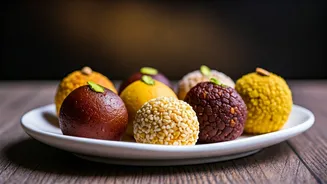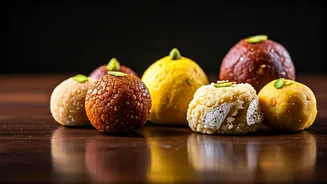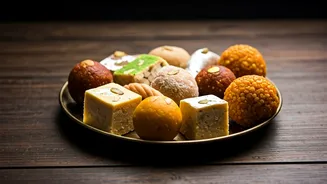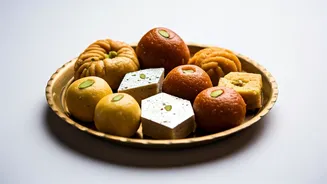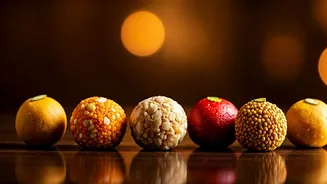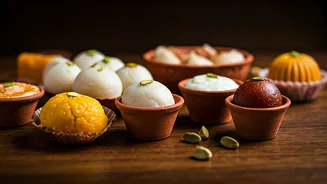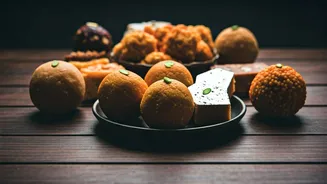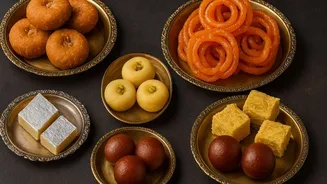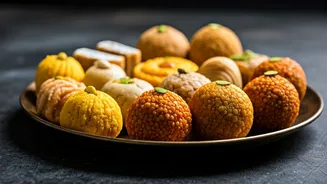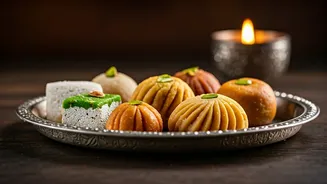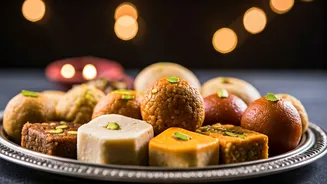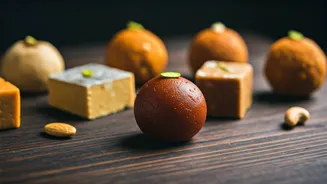Besan Laddoo
Besan laddoo, a staple in many Indian homes, is primarily crafted from gram flour (besan), ghee, and sugar. The process begins with roasting the besan in ghee until
it turns fragrant and golden. Once roasted, sugar, often powdered, is mixed in, along with cardamom for flavor, before the mixture is shaped into round balls. This laddoo is a popular offering to Lord Ganesha, often served during festivals like Ganesh Chaturthi. The soft texture and rich taste make it a delightful treat, symbolizing prosperity and good fortune. Its simplicity in ingredients and preparation adds to its charm, making it a favorite for both home celebrations and temple offerings.
Motichoor Laddoo
Motichoor laddoo, known for its small, bead-like appearance, is another beloved sweet often presented to deities. The preparation involves making tiny balls (motis) from a batter of gram flour, deep-frying them, and then soaking them in sugar syrup. This process gives the laddoo its characteristic texture and sweetness. Cardamom and saffron are frequently added to enhance the flavor and aroma. The texture is usually slightly granular and melt-in-your-mouth. The vibrant color and intricate appearance make it an appealing offering, widely presented to Lord Ganesha and other deities during auspicious occasions, representing abundance and blessings.
Coconut Laddoo
Coconut laddoo offers a tropical twist to traditional offerings, primarily comprising grated coconut, sugar or jaggery, and often milk or condensed milk. The coconut is typically roasted to bring out its natural flavors and then combined with the sweetener and other ingredients, often infused with cardamom. The mixture is then cooked until it thickens, allowing it to be shaped into laddoos. The use of coconut is significant in Hindu rituals, symbolizing purity and auspiciousness. This laddoo is frequently presented to various deities, particularly during festivals and special pujas, offering a refreshing and naturally sweet treat.
Rava Laddoo
Rava laddoo utilizes semolina (rava or suji) as its main ingredient, combined with ghee, sugar, and sometimes nuts like cashews and raisins. The semolina is roasted in ghee until it emits a pleasant aroma. Sugar syrup, or powdered sugar, is then mixed in, along with nuts and flavoring agents such as cardamom and saffron. The mixture is shaped into laddoos once it cools down. Rava laddoos are commonly offered to deities during various festivals and celebrations. The slightly grainy texture and rich taste, combined with the presence of nuts, make it a delightful offering representing completeness and gratitude in Hindu traditions.
Peanut Laddoo
Peanut laddoo, a nutritious offering, is made from roasted peanuts, jaggery or sugar, and often flavored with cardamom or other spices. The peanuts are ground or crushed and then mixed with melted jaggery or a sugar syrup to bind them together. This mixture is then shaped into laddoos. Peanut laddoos are particularly popular during winter and are often offered to deities during various festivals, offering a good source of energy and protein. The use of peanuts in these laddoos symbolizes the earth's bounty and is associated with good health and vitality in Hindu culture.
Til Laddoo
Til laddoo, prepared from sesame seeds (til) and jaggery or sugar, is a traditional sweet often enjoyed during winter and festivals like Makar Sankranti. The sesame seeds are dry-roasted until they become aromatic, and jaggery is melted to form a syrup. These ingredients are then combined and shaped into laddoos while still warm. Sesame seeds represent prosperity and good luck, while jaggery adds a rich, unrefined sweetness. Til laddoos are often offered to deities as a symbol of gratitude and are associated with good fortune and health in Hindu religious practices.
Dry Fruit Laddoo
Dry fruit laddoo represents a more luxurious offering, commonly made with a blend of various dry fruits such as almonds, cashews, raisins, dates, and figs, mixed with ghee, sugar or jaggery, and flavored with cardamom or other spices. The dry fruits are roasted or slightly sautéed to bring out their flavors, then chopped and mixed with the sweetener, typically bound together with a touch of ghee. This mixture is then formed into laddoos. Dry fruit laddoos are considered a symbol of abundance and are frequently offered to deities during special occasions, representing wealth and blessings in Hindu traditions. These laddoos provide a rich blend of flavors, textures, and nutrients.
